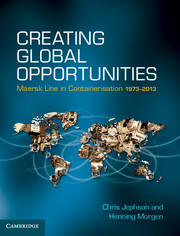Book contents
- Frontmatter
- Dedication
- Contents
- List of figures
- List of tables
- List of Economist Intelligence Unit data
- List of boxes
- Acknowledgements
- Glossary
- Prologue
- 1 ‘Per Aspera Ad Astra’
- 2 The Coming Revolution
- 3 The Decision
- 4 Building the Base (1978–1984)
- 5 Planning the Next Steps (1984–1987)
- 6 Laying the Foundations for Expansion (1987–1990)
- 7 The 1990s
- 8 The Acquisition Trail (1992–1998)
- 9 1999 A Year of Developments and Acquisitions
- 10 Into the New Millennium (2000–2005)
- 11 P&O NedLloyd (2005–2007)
- 12 A New Strategy (2008–2013)
- Epilogue
- Notes and References
- Index
Epilogue
Published online by Cambridge University Press: 05 April 2014
- Frontmatter
- Dedication
- Contents
- List of figures
- List of tables
- List of Economist Intelligence Unit data
- List of boxes
- Acknowledgements
- Glossary
- Prologue
- 1 ‘Per Aspera Ad Astra’
- 2 The Coming Revolution
- 3 The Decision
- 4 Building the Base (1978–1984)
- 5 Planning the Next Steps (1984–1987)
- 6 Laying the Foundations for Expansion (1987–1990)
- 7 The 1990s
- 8 The Acquisition Trail (1992–1998)
- 9 1999 A Year of Developments and Acquisitions
- 10 Into the New Millennium (2000–2005)
- 11 P&O NedLloyd (2005–2007)
- 12 A New Strategy (2008–2013)
- Epilogue
- Notes and References
- Index
Summary
There was not much new technology involved in the idea of moving a truck body off its wheels and onto a cargo vessel . . . but . . . without it, the tremendous expansion of world trade in the last 40 years – the fastest growth in any major economic activity ever recorded, could not possibly have taken place.
Peter DruckerPutting the economic development into perspective
In 1950, when one of the authors travelled as a young child by a British Overseas Aircraft Corporation flight (BOAC, the precursor to today’s British Airways) from England to Jakarta in Indonesia, it took about five days to get there and was seen as a rare privilege. Flying in a four-engined, piston-driven Lockheed Constellation, known familiarly as the ‘flying banana’ because of its shape, the flights took place mainly during daylight hours, as little radar and few navigational aids existed at the time. Today, such travel is commonplace. Bali, in Indonesia, is a major tourist holiday resort for people from all over the world and flights to New Zealand from Europe, about as far as one can travel, take only 24 hours.
Maersk Line had been serving Indonesia regularly since 1929, and as part of expanding the liner network in Southeast Asia in the 1950s, Harrisons and Crossfield were appointed as agents in 1953. The liner services of the early 1950s, like the flights, were a very different story from those of 2013. Then, Maersk Line’s ships, scheduled to arrive on a certain day rather than at a certain hour, berthed at quays in or near the city centre near the all-important infrastructure of roads and railways, rather than at terminals located far away, as today. The ships often stayed in port for days rather than hours, allowing time for gangs of longshoremen to unload or load the cargo, which consisted of many small boxes, bales and drums, rather than today’s many large containers. It was a different world and, just as in the skies, the revolution in sea transport has changed the way we look at and live in a globalised world.
- Type
- Chapter
- Information
- Creating Global OpportunitiesMaersk Line in Containerisation 1973–2013, pp. 362 - 381Publisher: Cambridge University PressPrint publication year: 2014



